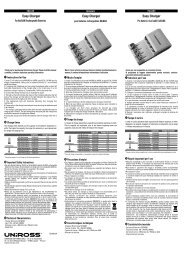UNIROSS Study on the Environmental Impact of ... - Battery Logic
UNIROSS Study on the Environmental Impact of ... - Battery Logic
UNIROSS Study on the Environmental Impact of ... - Battery Logic
You also want an ePaper? Increase the reach of your titles
YUMPU automatically turns print PDFs into web optimized ePapers that Google loves.
Printed <strong>on</strong> recycled paper<br />
Results <strong>of</strong> <strong>the</strong> study 3<br />
All rights reserved – 2007 – Uniross<br />
Source: Uniross study carried out by Bio Intelligence Service<br />
Equivalences<br />
In terms <strong>of</strong>…<br />
The impact <strong>of</strong> a rechargeable<br />
battery is equal to :<br />
Reference<br />
units<br />
Equivalence<br />
in disposable batteries:<br />
C<strong>on</strong>sumpti<strong>on</strong> <strong>of</strong> n<strong>on</strong>renewable<br />
natural resources<br />
1 k kg <strong>of</strong> petroleum extracted v 19<br />
Climate change 16 k km driven by car v 457<br />
Photochemical oxidati<strong>on</strong> 73 k km driven by car v 2 320<br />
Air acidificati<strong>on</strong> 2 122 k km driven by car v 19 812<br />
Sedimentary ecotoxicity 227 k mg <strong>of</strong> mercury emitted into <strong>the</strong> water v 2 731<br />
If all <strong>of</strong> <strong>the</strong> disposable batteries in Europe were replaced with rechargeable batteries, it would avoid:<br />
In terms <strong>of</strong>…<br />
C<strong>on</strong>sumpti<strong>on</strong> <strong>of</strong> n<strong>on</strong>-renewable<br />
natural resources<br />
II Methodology<br />
1. Life cycle analysis<br />
Avoiding an impact Avoiding an impact<br />
corresp<strong>on</strong>ding to X Europeans / year corresp<strong>on</strong>ding to<br />
106 000 210 900 t<strong>on</strong>nes <strong>of</strong> petroleum extracted<br />
If we replace all disposable batteries If we replace all disposable batteries in Europe<br />
in Europe with rechargeable <strong>on</strong>es, with rechargeable <strong>on</strong>es, we would avoid<br />
we would avoid <strong>the</strong> impact that an impact <strong>on</strong> <strong>the</strong> c<strong>on</strong>sumpti<strong>on</strong> <strong>of</strong> n<strong>on</strong>-renewable<br />
106,000 Europeans have <strong>on</strong> <strong>the</strong> c<strong>on</strong>sumpti<strong>on</strong> natural resources that is comparable<br />
<strong>of</strong> n<strong>on</strong>-renewable natural resources. to extracting 210,900 t<strong>on</strong>s <strong>of</strong> petroleum.<br />
Climate change 62 110 5 billi<strong>on</strong> km driven by car<br />
Photochemical oxidati<strong>on</strong> 136 820 25 620 billi<strong>on</strong> km driven by car<br />
Air acidificati<strong>on</strong> 109 000 201 700 billi<strong>on</strong> km driven by car<br />
Sedimentary ecotoxicity 90 410 29 t<strong>on</strong>nes <strong>of</strong> mercury emitted into <strong>the</strong> water<br />
The <str<strong>on</strong>g>UNIROSS</str<strong>on</strong>g> study was based <strong>on</strong> <strong>the</strong> comparative Life Cycle Analysis method (LCA) for a<br />
rechargeable battery and its equivalence in disposable batteries.<br />
This in–depth analysis is used to evaluate <strong>the</strong> envir<strong>on</strong>mental impact <strong>of</strong> a product throughout its<br />
life cycle:<br />
Producti<strong>on</strong> <strong>of</strong> disposable batteries and rechargeable batteries (and <strong>the</strong> charger), including <strong>the</strong><br />
extracti<strong>on</strong> <strong>of</strong> raw materials, producti<strong>on</strong> <strong>of</strong> <strong>the</strong> basic comp<strong>on</strong>ents and assembly <strong>of</strong> <strong>the</strong> product.<br />
Sale in shops, to <strong>the</strong> end-user customer (transport, etc.). For disposable batteries, <strong>the</strong> study also<br />
takes into account <strong>the</strong> repetiti<strong>on</strong> <strong>of</strong> this step in <strong>the</strong> analysis <strong>of</strong> <strong>the</strong> life cycle.<br />
Use phase: this represents energy c<strong>on</strong>sumpti<strong>on</strong> when recharging rechargeable batteries.<br />
End <strong>of</strong> life: this covers waste collecti<strong>on</strong> and treatment (recycling, incinerati<strong>on</strong> or burial).<br />
The life cycle <strong>of</strong> a disposable battery is much shorter than that <strong>of</strong> a rechargeable battery; thus, to<br />
obtain <strong>the</strong> same quantity <strong>of</strong> energy, i.e. 1 kWh (unit adopted for <strong>the</strong> study), <strong>the</strong> c<strong>on</strong>sumer must<br />
repeat his purchase several times. The manufacturer must produce more batteries which would<br />
generate more polluti<strong>on</strong> and use more natural resources. Lastly, <strong>the</strong> life cycle also entails <strong>the</strong><br />
emissi<strong>on</strong> <strong>of</strong> greenhouse gases from <strong>the</strong> transport and distributi<strong>on</strong> <strong>of</strong> <strong>the</strong> products.<br />
On <strong>the</strong> basis <strong>of</strong> this life cycle analysis, a rechargeable battery eco-pr<strong>of</strong>ile was created. The<br />
eco-pr<strong>of</strong>ile is <strong>the</strong> product’s “envir<strong>on</strong>mental identity card”.



